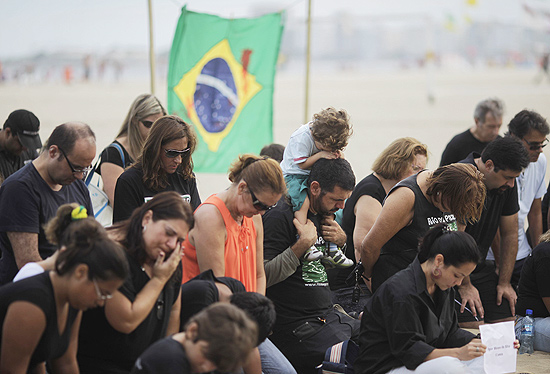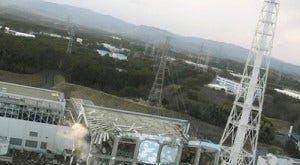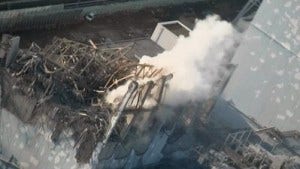Editor's note: We will update our earthquake news as frequently as possible on AJW's Facebook page: http://www.facebook.com/AJW.Asahi. Please check the latest developments in this disaster. From Toshio Jo, managing editor, International Division, The Asahi Shimbun.
* * *
Although lionized as the "Fukushima 50" by the foreign media, there are in fact about 700 workers engaged in the daily struggle with the "invisible enemy" at the crippled Fukushima No. 1 nuclear power plant.
A month has passed in the dangerous and lonely efforts to resolve the crisis at the nuclear plant, and still, there is no end in sight. There are many tales emerging of the unselfishness and bravery of these workers, while others take a more realistic view of why they are risking their lives amid high radiation levels to cool down the plant's overheating fuel rods.
A man in his 40s, who was dispatched to Fukushima No. 1 from a partner of the plant's operator, Tokyo Electric Power Co. (TEPCO), said, "I did not want to go there. But if I reject the request, I will lose my job."
The daily pay is less than 20,000 yen ($236).
"I hear some construction workers were employed at a wage of several tens of thousands of yen per hour. But we are working on a conventional daily wage as our company has had cooperative relationships with TEPCO," the man said.
Meanwhile, many of the man's colleagues volunteered to go into the plant, saying, "We are the only workers (that can do the job)." Because of that gung-ho spirit, they share a sense of solidarity, the man added.
At one of the plant's subcontractors, the president and elderly executives volunteered, hoping that they would be chosen instead of younger workers, because they were worried about the long-term health effects on them.
"Even we can do simple work, such as laying cables," one of the elderly executives said.
Immediately after the March 11 Great East Japan Earthquake, the number of TEPCO employees and others from the firm's business partners, such as Toshiba Corp. and Hitachi Ltd., at Fukushima No. 1 totaled more than 700. After an explosion took place at a building housing the No. 2 reactor on March 15, however, most of them evacuated. Only about 70 workers remained and continued the recovery work.
Their number was initially announced as 50. Because of that, foreign media labeled them the "Fukushima 50," and the heroic tag stuck.
Today, the more accurate "Fukushima 700" at the plant are classified into such groups as "recovery," "information," "medical service" and "security."
When the crisis began in mid-March, many workers stayed in the plant's compound for more than 10 days in a row. At present, they are working in alternate shifts, taking two days off at a time.
This month, a TEPCO employee living in the Tokyo metropolitan area told his wife, "I may have to go (to the Fukushima No. 1 nuclear power plant) again."
He went to the plant several days after the earthquake and continued to stay there. Recently, he was allowed to return home. Even at his office in Tokyo, however, he is working from early in the morning to midnight every day, and there is little time to talk with family members.
"Even if you have no health problems now, will you be in good health in the future?" his concerned wife asked him.
Meanwhile, heated exchanges took place during a meeting of a group company of Hitachi, immediately after the nuclear crisis began.
An employee of the section in charge of the recovery work at the Fukushima No. 1 nuclear power plant challenged an employee in charge of engineering management: "How many workers can you send (to the nuclear plant)? Show us your determination."
To resolve the crisis, the employee urged the latter to share in the on-site work at the nuclear plant instead of issuing orders from a safe distance. As a result of the discussion, many engineers went into the nuclear plant.
A mid-level executive of the company recalled, "It was a difficult decision," as the job could endanger the lives of the workers.
What workers found at Fukushima No. 1 in the beginning was a lack of adequate safety equipment and spartan living conditions.
At the start of the nuclear crisis, there was an insufficient number of dosimeters to measure radiation levels. Because of that, about 180 workers were engaged in the recovery work without them.
Their living conditions were poor. They had only hard biscuits and vegetable juice in the morning and canned food and emergency rice at night. They slept on floors during their shifts.
Currently, the workers have meals three times a day, and some can stay at facilities located away from the plant. According to TEPCO sources, every worker now has access to a dosimeter.
However, many workers say that they may have already been exposed to much radiation.
In late March, the radiation level rose in a building that is serving as the headquarters of the recovery work efforts, alarming the workers.
The building is equipped with an air-conditioning system that does not let in outside air and the walls are also thick. TEPCO has additionally replaced filters for air ventilation with new ones. It also installed 77 lead-covered boards on windows to prevent gamma rays from entering the building,
An employee of a company that has dispatched its workers to the Fukushima plant added, "We want to make the dispatched workers wear lead-lined suits."
The Fukushima No. 1 nuclear power plant had "whole body counters," which measures "internal exposure," or level of radiation in the human body. However, those counters were rendered useless due to damage from the earthquake and subsequent tsunami. The internal exposure is now measured by inspection vehicles.
Despite the precautions for worker safety at Fukushima No. 1, there is concern.
"Some workers may have radiation-caused symptoms after several years," said Atsushi Suzuki, a lawyer who previously handled a labor disaster compensation issue for a nuclear power plant worker.
Suzuki represented a man who worked at the Fukushima No. 1 plant from 1977 to 1982 as a plumber and on other jobs.
After he left the workplace, he was diagnosed as suffering from multiple myeloma, a deadly bone marrow cancer. He died in 2007.
The man was recognized to have died from exposure to radiation. In a suit seeking compensation, however, TEPCO did not acknowledge its responsibility. As a result, his demand for compensation was rejected.
"It is extremely difficult to prove scientifically the cause-and-effect-relationship between exposure to radiation and a disease that broke out later," Suzuki said. "I think that people currently engaged in recovery work (at the Fukushima No. 1 plant) do not have the leeway to prevent exposure to radiation by themselves. It is necessary for the government and TEPCO to fully consider sufficient prevention measures and compensation (to those who suffered radiation-caused diseases)."
(This article was written by Manabu Sasaki, Hiroyoshi Itabashi, Hiroaki Kojima and Ryujiro Komatsu.)
 A Justiça do Rio decretou nesta segunda-feira a quebra do sigilo eletrônico de Wellington Menezes de Oliveira, 23, que atirou contra alunos da escola municipal Tasso da Silveira, em Realengo (zona oeste), matando 12 deles na quinta-feira (7).
A Justiça do Rio decretou nesta segunda-feira a quebra do sigilo eletrônico de Wellington Menezes de Oliveira, 23, que atirou contra alunos da escola municipal Tasso da Silveira, em Realengo (zona oeste), matando 12 deles na quinta-feira (7).  Veja os papéis encontrados na casa do atirador
Veja os papéis encontrados na casa do atirador

![Validate my Atom 1.0 feed [Valid Atom 1.0]](valid-atom.png)




























































 Comments (
Comments (
